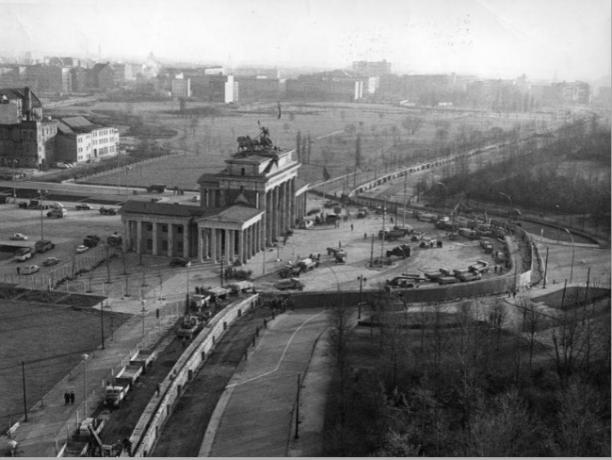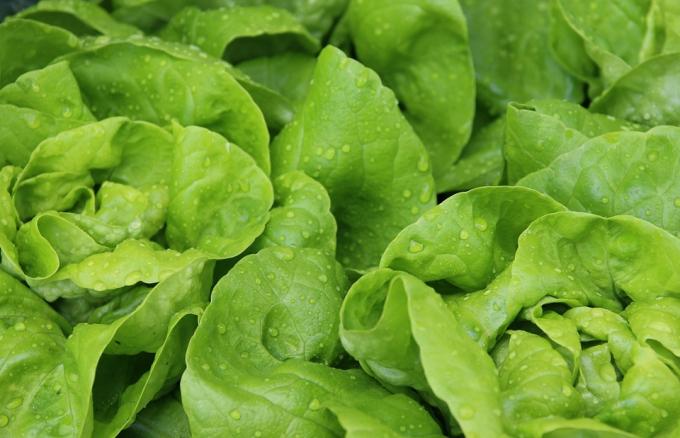The Berlin Wall was a concrete wall that began to be built in the city of Berlin and that divided Germany physically and ideologically, from 1961 to 1989, in two parts:
- German Democratic Republic (which used the socialist regime led by the Soviet Union);

Flag of the German Democratic Republic (East Germany)
- Federal Republic of Germany (which used the capitalist regime).

Flag of the Federal Republic of Germany (West Germany)
Construction of the Berlin Wall
In day August 13, 1961, Walter Ulbricht, then president of the eastern side of Germany, ordered troops and army vehicles to make a barrier to prevent the passage of any civilians.
During the next morning, construction began. This beginning did not take into account the streets or buildings that already existed in the area.
As everything happened overnight, many families, friends and neighbors were suddenly separated and stayed that way for nearly three decades.
The eastern part of the country claimed that the construction of the wall was intended to protect its population from the elements. fascists who conspired against the will of the people to build a socialist state in the eastern part of the Germany.
In fact, the wall was built to prevent the massive emigration that marked East Germany during the post-World War II period.
The German side that was under Soviet control was experiencing serious economic and social difficulties and for this reason many people tried to flee to the west.

Berlin Wall in the year of its construction (1961)
Throughout the construction of 155 km, there were more than 300 observation towers with guards and a wide area known as the "death strip", consisting of "fakir beds" (lawns with nails), anti-vehicle ditches and other types of defenses such as bars with alarms, electric fences, barbed wire, patrols with guard dogs and soldiers armed.
Division of German territory with the Berlin wall
Germany was divided into 4 sectors of occupation after World War II: soviet, American, French and English.
The three western sectors (American, French and English) were governed by capitalism and the eastern sector (Soviet) followed socialism.

The Berlin Wall created a barrier between the entire Soviet part and the western part
Relationship between the Berlin Wall and the Cold War
The construction of the Berlin Wall became a great symbol of the Cold War as it divided German territory into ocidental Germany, which concentrated liberal capitalist democracies and Oriental Germany, where were several communist states.
East Germany came under the influence of the USSR and West Germany under the influence of the USA, countries that at that time in history represented the two main world powers.
The eastern part was mostly agricultural and was not prepared to put into practice the plans established by the USSR after the war.
The economic and social system implemented by the Soviets generated unsatisfactory results for the population. Many tried to flee to the West, in search of the better living conditions that those who lived under the American policy of capitalism seemed to have.
Learn more about Cold War, a USSR it's the capitalism.
fall of the berlin wall
On November 9, 1989, the German population was informed by the East German Communist Party that the crossing between East Germany and West Germany was cleared.

Thousands of people flocked to the site to celebrate and contribute to the end of separatist construction.

The population itself started the demolition of the wall.
The historic event was broadcast live on television and accompanied by people from around the world. However, the official demolition of the Berlin Wall only started on the day June 13, 1990.
The fall of the wall in 1989 heralded the imminent end of the Cold War, which ended in 1991.
The entire capitalist world celebrated the fall of the wall, as for them it represented a defeat of communism.
Consequences of the fall of the Berlin Wall
The main consequences of the fall of the Berlin Wall were the dissolution of the USSR it's the end of the cold war in 1991, and the reintegration of Germany.
By the 1980s, the USSR was already demonstrating that it was no longer able to face the competitiveness imposed by American capitalism. The costs of the war in Afghanistan and the maintenance of military materiel combined with other economic problems, put an end to the communist bloc.
With the end of the USSR, Germany was unified and became a stronger country.
know more about communism, characteristics of communism and communism and socialism.
Curiosities about the Berlin Wall
The emergence of this barrier gave rise to two territories that practically did not communicate.
See below some curiosities related to the Berlin Wall:
It was built to prevent professionally qualified people from leaving
The eastern side lived in worse economic conditions than the western side, which was run by a capitalist system.
For this reason, there were many people who wanted to flee and try to make a better life in West Germany.
One of the reasons for the construction of the wall was to curb the emigration of inhabitants from the Soviet part of the city, preventing the Orient from lagging behind professionals such as doctors, engineers, teachers, etc.
The wall has undergone some renovations over the years

Image of the Berlin wall in 1980, with concrete slabs
During your long 28 years of existence, the Berlin Wall has undergone several changes.
Originally built in a more basic way, with fences, barbed wire and improvised guardhouses, the wall gained an increasingly solid structure.
Over time, the construction began to rely on concrete slabs and more than 300 surveillance towers were deployed, where more than 11,000 soldiers worked.
Berlin Wall Features
The Berlin Wall was a construction of 155 km, along which there were more than 300 observation towers with guards.
The walls, which were initially formed by sidings, have been reformed over the years with concrete slabs, etc., in order to increase strength.
To prevent the escape of inhabitants who lived on the other side, a large area was created next to the wall with nails, bars with alarms, electric fences, barbed wire, etc.
Many died trying to get to the other side of the Berlin Wall
Over the nearly three decades of the wall's existence, more than 100,000 people risked their lives trying to cross it.
According to the Central Register of State and Institutional Crime, located in the city of Salzgitter, the death toll is around 872 people, counting not only fugitives but also soldiers.

Berlin wall memorial with photos of victims
This number, however, is still the subject of questioning and discussions to this day.
In addition to all the apparatus created to stop the fugitives (such as electric fences, nails, guard dogs, etc.), the soldiers responsible for the surveillance had orders to shoot anyone who dared to defy the limits imposed by the wall, an order that became known as "Order 101".
The last two people to lose their lives trying to cross the wall were Chris Gueffroy (June 21, 1968 – February 6, 1989), who was shot ten times in the chest by surveillance soldiers and Winfried Freudenberg (August 29, 1956 – March 8, 1989), who tried to cross the wall in a balloon and was found lifeless in a village garden after the transport crash.

Chris Gueffroy on the left and Winfried Freudenberg on the right
It was possible to pass to the other side of the wall at specific points
Amazingly, it was possible to cross the wall in specific places.
There were a total of eight tickets but they were only authorized for West Berlin citizens, West Germans, West foreigners and government officials. Allies in East Berlin, citizens of the German Democratic Republic and citizens of other socialist countries in West Berlin, provided they have the permits needed.
The most famous crossing point was a military outpost called Checkpoint Charlie.
The Berlin Wall Today
As the demolition of the Berlin wall had the direct participation of the local population, many were the people who kept parts of the construction as souvenirs.
Even today, it is possible to find someone who will auction these souvenirs.
Some of the pieces can even be found for sale in souvenir shops for tourists.

